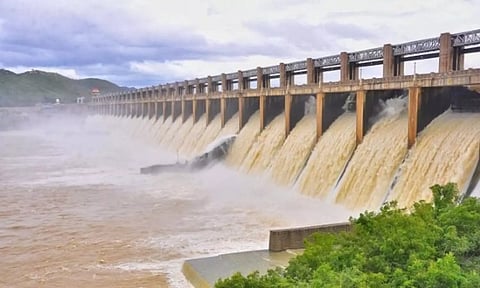

CHENNAI: By the looks of it, the Cauvery water-sharing dispute is nowhere close to being resolved. Karnataka CM Siddaramaiah said the State has decided to appeal before the Supreme Court against the Cauvery Water Regulation Committee’s (CWRC) directive to release 3,000 cusecs of water to Tamil Nadu for 18 days, starting from Sept 28. He added that Karnataka does not have sufficient water in four dams in the river basin to release the aforementioned quantum to Tamil Nadu on a daily basis.
As on Friday, the upper riparian state’s Krishnaraja Sagar reservoir had 42% storage, compared to 97% recorded during the corresponding period last year. Storage in Kabini was 69% (from 96% in 2022), Harangi had 80% storage (compared to 90% last year), while Hemavathi’s storage hovered around 50% (from 99% in 2022). Compare this to the storage in Tamil Nadu’s Mettur reservoir which has just about 12% as against the storage of 96% of last year.
At the Cauvery Water Management Authority’s meeting on Friday, the Tamil Nadu government reiterated its demand that Karnataka release water at the rate of 12,500 cusecs daily. Currently, 2,000 cusecs of water flows into our state every day. The administration in Karnataka is mulling alternative arrangements to release 1,000 cusecs more to TN. The episode prompted a war of words between the two governments — Karnataka witnessing two state bandhs called by pro-Kannada organisations in one week itself.
Our ‘water-starved neighbour’ is pinning its hopes on ample rains during the northeast monsoon to tide over its troubles, with reports estimating normal rains to the tune of 182 mm, which will be essential to help mitigate its drought woes. However, a clause in CWRC’s latest order has asked Karnataka to release a backlog of 12.2 tmcft to Tamil Nadu in October, which has become a cause for anxiety in Bengaluru.
The need for a distress-sharing formula was voiced early on in June 1991, when the Cauvery Water Disputes Tribunal gave its interim order. In 2018, the Supreme Court had mandated that Karnataka release a total of 117 tmcft between June 1 and Sept 25 to Tamil Nadu. However, a 53% deficit in inflows into reservoirs in the Cauvery basin had prevented Karnataka from complying with this order. This is in spite of the fact that the judicial bodies had referred to the principle of pro-rata sharing in times of distress. The re-emergence of this dispute highlights the need for a regular formula to share the shortfall and distress in periods of monsoon failure.
Political ramifications rank on top in the list of agents responsible for this impasse. Leaders have often relied on maintaining the status quo as opposed to taking bold, reformative action. But such disputes risk intensifying due to other causes too – erratic and deficient rainfall, speedily diminishing groundwater reserves, changes in the use of land, as well as cropping techniques that are water-intensive.
The need of the hour is a distress-sharing formula conceived in a rational and objective manner. Those with the domain expertise need to step in should ensure that the facts of the matter are placed under the public’s purview in a transparent and lucid manner. This will prevent regionalistic agents to lend the issue a political tint. It will also prevent the problem being reduced to a seasonal malady that needs to be adjudicated on an annual basis.